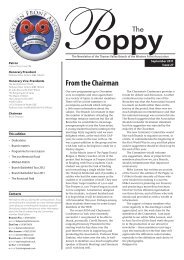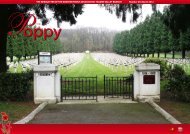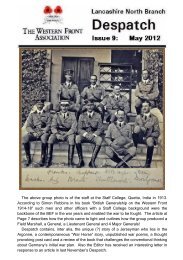Up_the_Line_July_2012.pdf - The Western Front Association
Up_the_Line_July_2012.pdf - The Western Front Association
Up_the_Line_July_2012.pdf - The Western Front Association
You also want an ePaper? Increase the reach of your titles
YUMPU automatically turns print PDFs into web optimized ePapers that Google loves.
TONIGHT’S TALK -<br />
16th (Irish) Division<br />
<strong>The</strong> British army’s 16th (Irish) Division was raised September 11, 1914, part<br />
of <strong>the</strong> second wave of Field Marshal Kitchener’s volunteer “New Army”<br />
divisions designed to augment Britain’s six professional divisions which<br />
Kaiser Wilhelm II had described as a “Contemptible Little Army.”<br />
Formed in sou<strong>the</strong>rn Ireland under <strong>the</strong> command of Lieutenant-General<br />
Sir Lawrence Parsons, himself an Irish Protestant, <strong>the</strong> division was <strong>the</strong><br />
embodiment of Nationalist and Catholic Ireland. Indeed, Parsons received<br />
orders to clear <strong>the</strong> division’s 47th Brigade of its earlier recruits in order<br />
to receive men from <strong>the</strong> paramilitary National Volunteers who were<br />
encouraged to join this “Irish Brigade” by Nationalist MP John Redmond*.<br />
<strong>The</strong> Flag 1914. Redmond presents a colour to <strong>the</strong> Volunteers.<br />
In December 1915, <strong>the</strong> division moved to France, joining <strong>the</strong> British<br />
Expeditionary Force (BEF), under <strong>the</strong> command of Irish Major General<br />
William Hickie, and spent <strong>the</strong> duration of <strong>the</strong> First World War in action<br />
on <strong>the</strong> <strong>Western</strong> <strong>Front</strong>. Following enormous losses at <strong>the</strong> Somme,<br />
Passchendaele and Ypres, <strong>the</strong> Division required a substantial refit in<br />
England between June and August 1918, which involved <strong>the</strong> introduction<br />
of many non-Irish battalions. <strong>The</strong> division served as a formation of <strong>the</strong><br />
United Kingdom’s British Army during World War I.<br />
History<br />
<strong>The</strong> Division began forming as part of <strong>the</strong> K2 Army Group towards <strong>the</strong><br />
end of 1914 after Irish recruits in <strong>the</strong> early days of <strong>the</strong> war from England<br />
and Belfast first filled <strong>the</strong> ranks of <strong>the</strong> 10th (Irish) Division before being<br />
assigned to <strong>the</strong> 16th Division, formed around a core of National Volunteers.<br />
Initial training began in Ireland at Fermoy, Munster; recruits also trained at<br />
Buttevant. It moved to Aldershot<br />
in England for more intensive<br />
training in September 1915. After<br />
thirteen weeks, <strong>the</strong> formation was<br />
deployed to Etaples in France,<br />
joining <strong>the</strong> BEF, from where it left<br />
on December 18 for that part of <strong>the</strong><br />
front in <strong>the</strong> Loos salient, under <strong>the</strong><br />
command of Irish Major General<br />
William Hickie. It spent <strong>the</strong> rest of<br />
<strong>the</strong> war on <strong>the</strong> <strong>Western</strong> <strong>Front</strong>.<br />
At Loos, in January and February<br />
1916, <strong>the</strong> division was introducted<br />
to trench warfare and suffered<br />
greatly in <strong>the</strong> Battle of Hulluch, 27–<br />
29 April, (during <strong>the</strong> Easter Rising in<br />
Ireland). Personnel raided German<br />
trenches all through May and June,<br />
and in late <strong>July</strong> <strong>the</strong>y were moved to<br />
<strong>the</strong> Somme Valley where <strong>the</strong>y were<br />
intensively engaged in <strong>the</strong> Battle<br />
of <strong>the</strong> Somme. <strong>The</strong> 16th division<br />
played an important part in<br />
capturing <strong>the</strong> towns of Guillemont<br />
and Ginchy, although <strong>the</strong>y suffered<br />
massive casualties. During <strong>the</strong>se<br />
successful actions between 1<br />
and 10 September casualties<br />
Guillemont and Ginchy Memorial amounted to 224 officers and 4,090<br />
men; despite <strong>the</strong>se very heavy losses <strong>the</strong> division gained a reputation as<br />
first-class shock troops. Out of a total of 10,845 men, it had lost 3,491 on<br />
<strong>the</strong> Loos sector between January and <strong>the</strong> end of May 1916, including<br />
heavy casualties from bombardment and a gas attack at Hulluch in April<br />
Blletting of this order was fatal to <strong>the</strong> division’s character, for it had to be<br />
made good by drafts from England.<br />
In early 1917, <strong>the</strong> division took a major part in <strong>the</strong> Battle of Messines<br />
alongside <strong>the</strong> 36th (Ulster) Division, adding to both <strong>the</strong>ir recognition and<br />
reputation. <strong>The</strong>ir major actions ended in <strong>the</strong> summer of 1917 at <strong>the</strong> Battle<br />
of Passchendaele after coming under <strong>the</strong> command of General Hubert<br />
Gough and <strong>the</strong> Fifth Army. In <strong>July</strong> 1917, during <strong>the</strong> Third Battle of Ypres,<br />
although both divisions were totally exhausted after 13 days of moving<br />
weighty equipment under heavy shelling, Gough ordered <strong>the</strong> battalions<br />
to advance through deep mud towards well fortified German positions<br />
left untouched by totally inadequate artillery preparation. By mid August,<br />
<strong>the</strong> 16th had suffered over 4,200 casualties, <strong>the</strong> 36th almost 3,600, or more<br />
than 50% of <strong>the</strong>ir numbers. General Haig was very critical of Gough for<br />
“playing <strong>the</strong> Irish card”.<br />
<strong>The</strong> 16th Division held an exposed position from early 1918 at Ronssoy<br />
where <strong>the</strong>y suffered more heavy losses during <strong>the</strong> German Spring<br />
Offensive in March and being practicaally wiped out in <strong>the</strong> retreat which<br />
followed Operation Michael, when <strong>the</strong>y helped to finally halt <strong>the</strong> German<br />
attack prior to <strong>the</strong> Battle of Hamel. <strong>The</strong> decision was <strong>the</strong>n made to break<br />
up <strong>the</strong> division, <strong>the</strong> three surviving Service battalions were posted<br />
to o<strong>the</strong>r formations. On 14 June <strong>the</strong> division returned to England for<br />
“reconstitution”. <strong>The</strong> Conscription Crisis of 1918 in Ireland meant that fewer<br />
Irish recruits could be raised so that <strong>the</strong> 16th Division which returned to<br />
France on 27 <strong>July</strong> contained five English Battalions, two Scottish Battalions<br />
and one Welsh Battalion. <strong>The</strong> only original Battalion left was <strong>the</strong> 5th Royal<br />
Irish Fusiliers.<br />
<strong>The</strong> dispersion of <strong>the</strong> Irish battalions throughout <strong>the</strong> BEF in 1918,<br />
despite its practical considerations, appears to suggest that <strong>the</strong> Irish units<br />
were increasingly distrusted by <strong>the</strong> military authorities.<br />
Wikipedia<br />
J E Redmond, Irish Parliamentary<br />
leader, H of C 1900 to 1918<br />
Copy, Word docs, pictures, jpegs, cuttings etc. by 31st August please to <strong>the</strong> Editor,<br />
Terry Jackson, 4 Scaliot Close, New Mills, SK22 3BX.<br />
Tel: 01663 740987<br />
Email: jackson.terence1@sky.com<br />
Chairman: Terry Jackson MA BA (Hons) MRICS<br />
Secretary: Position Available/Volunteer needed<br />
Venue: <strong>The</strong> Armoury (TA Centre),<br />
Greek Street, Stockport, SK3 8AX.<br />
Meeting on <strong>the</strong> second friday<br />
of every month. 7.30 for 8.00pm.<br />
Lancs. & Cheshire Branch Diary<br />
August 10th<br />
Sept. 14th<br />
October 12th<br />
November 9th<br />
NEXT ISSUE<br />
*John Edward Redmond (1<br />
September 1856 – 6 March 1918)<br />
was an Irish nationalist politician,<br />
barrister, MP in <strong>the</strong> House of<br />
Commons of <strong>the</strong> United Kingdom<br />
of Great Britain and Ireland and<br />
leader of <strong>the</strong> Irish Parliamentary<br />
Party from 1900 to 1918. He was<br />
a moderate, constitutional and<br />
conciliatory politician who attained<br />
<strong>the</strong> twin dominant objectives<br />
of his political life, party unity<br />
and finally in September 1914<br />
achieving Irish Home Rule under<br />
an Act which granted an interim<br />
form of self-government to Ireland.<br />
Unfortunately for Redmond,<br />
implementation of <strong>the</strong> Act was<br />
suspended by <strong>the</strong> intervention of<br />
World War I, and ultimately made<br />
untenable after <strong>the</strong> Conscription<br />
Crisis of 1918.<br />
1914-1918<br />
REMEMBERING<br />
Coalition Warfare by John Derry<br />
Disaster at Hooge 1915 (Flamethrower Attack)<br />
by Sean Godfrey<br />
Futureshock: Stories from <strong>the</strong> devastated zone<br />
by Rob Thompson<br />
Somme Success by Mike Stedman<br />
4



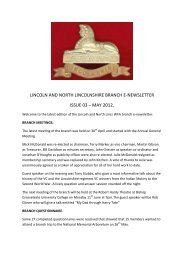

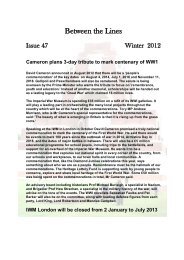

![Fromelles Australian Working List[1].pdf - The Western Front ...](https://img.yumpu.com/29972632/1/184x260/fromelles-australian-working-list1pdf-the-western-front-.jpg?quality=85)
